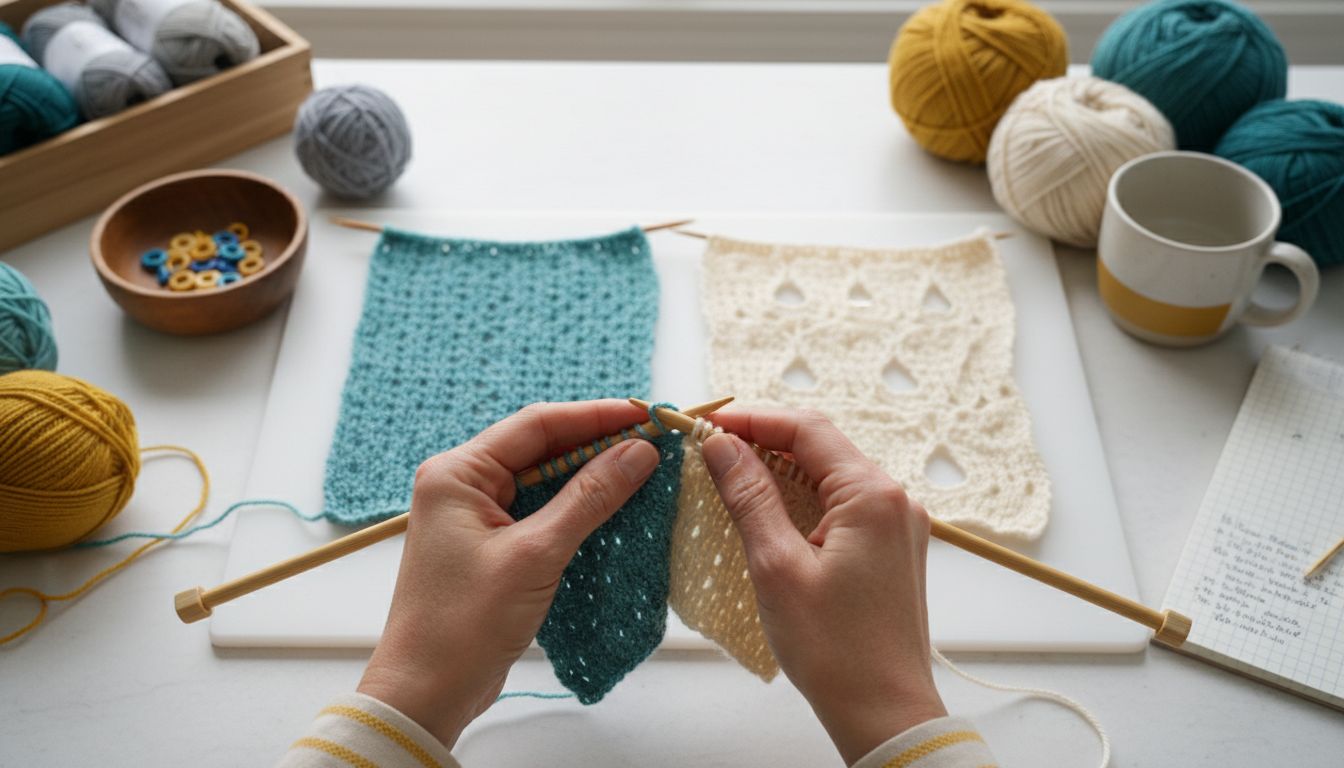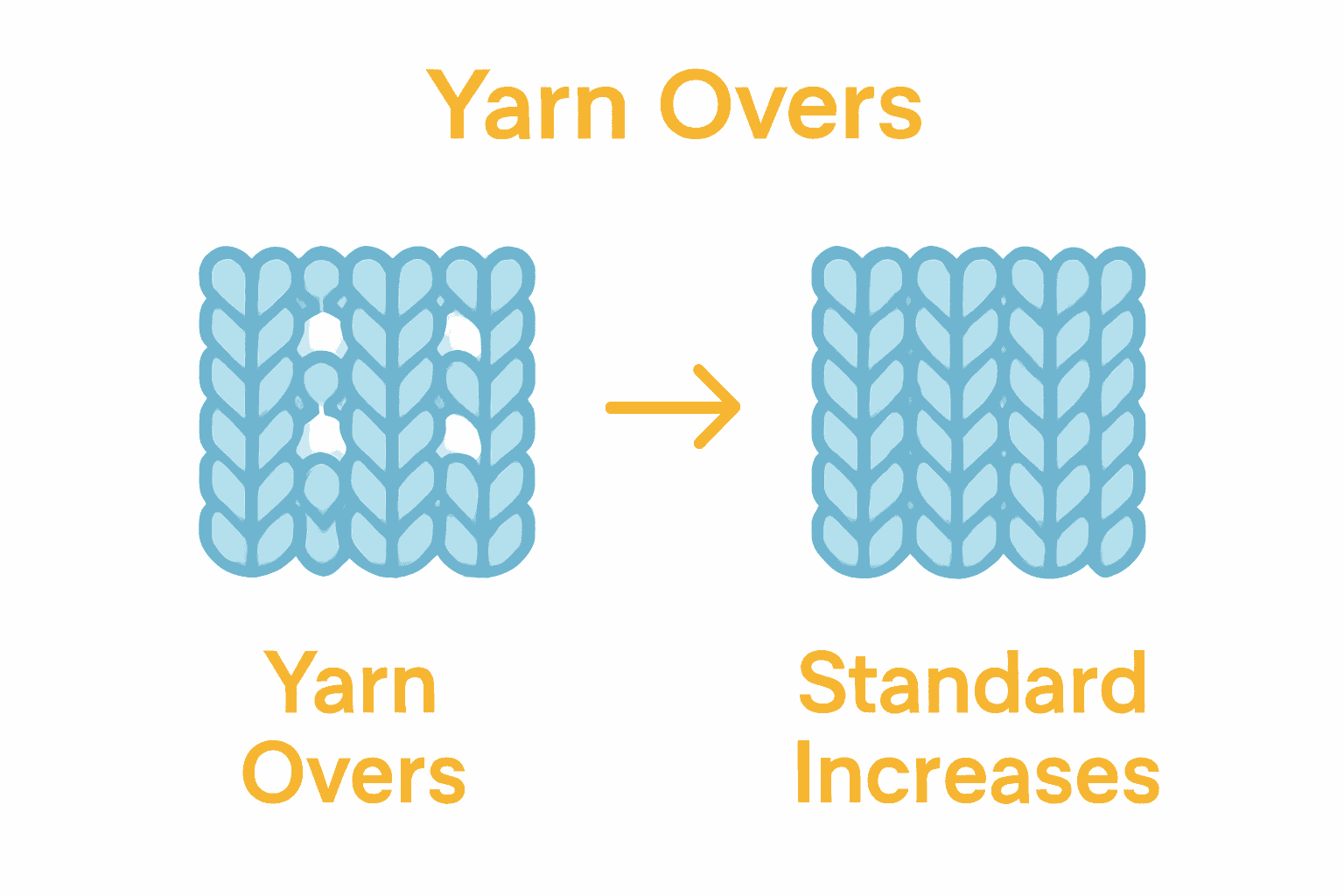
What Is Yarn Overs? Complete Guide for Crafters
Over 80 percent of lace knitting patterns rely on yarn overs to create their signature openwork designs. Whether you love crafting delicate shawls or experimenting with bold textures, understanding yarn overs is key to elevating your skills. Mastering this simple movement can turn plain fabric into artful patterns filled with eyelets and curves. This guide breaks down how yarn overs work in both knitting and crochet, making it easier to build confidence with every stitch.
Table of Contents
- Yarn Overs Defined For Knitting And Crochet
- Types Of Yarn Overs And Their Purposes
- How To Perform Yarn Overs Step By Step
- Common Uses And Creative Applications
- Mistakes To Avoid With Yarn Overs
- Yarn Overs Versus Similar Techniques
Key Takeaways
| Point | Details |
|---|---|
| Understanding Yarn Overs | Yarn overs are essential techniques for creating deliberate stitch increases and decorative patterns in both knitting and crochet. |
| Types of Yarn Overs | Key variations include standard, multiple wrap, and directional yarn overs, each offering unique textural effects in fabric. |
| Common Applications | Yarn overs are primarily used in lace knitting for delicate textures and openwork designs, enhancing the overall visual appeal. |
| Mistakes to Avoid | To achieve clean and consistent results, focus on maintaining even tension and properly counting yarn overs in your projects. |
Yarn Overs Defined for Knitting and Crochet
A yarn over is a fundamental technique in knitting and crochet that creates deliberate spaces or increases in your fabric, transforming ordinary patterns into intricate designs. According to Wikipedia, a yarn over involves passing the yarn over the right-hand needle, creating a new loop that can be knit on the subsequent row, which often produces a distinctive hole in the fabric.
The primary purpose of a yarn over is twofold: to increase stitch count and to generate decorative openwork patterns. Crafters use this technique extensively in lace knitting, where strategic yarn overs create delicate, airy textures. When executing a yarn over, you’ll simply bring the working yarn from back to front (or front to back, depending on your specific technique) over the needle before working the next stitch.
Yarn overs are versatile and appear in multiple craft contexts. In knitting, they’re commonly used to:
- Create intentional increases in stitch count
- Develop intricate lace patterns
- Generate decorative openwork designs
- Add visual interest to otherwise plain fabrics
For beginners, mastering yarn overs might seem challenging, but with practice, they become an intuitive part of your crafting repertoire. The key is understanding how to smoothly integrate the yarn over into your existing stitch pattern without disrupting the overall fabric structure. If you want to explore more foundational knitting techniques, check out our tutorial on crochet basics.
Types of Yarn Overs and Their Purposes
Yarn overs are incredibly versatile techniques with multiple variations that can dramatically transform your knitting and crochet projects. Wikipedia reveals that yarn overs can vary significantly based on the number of times the yarn is wrapped around the needle and the direction of the wrap, which directly impacts the resulting fabric’s texture and appearance.
Here are the primary types of yarn overs crafters should understand:
Standard Yarn Over
- Creates a single, simple increase in stitch count
- Produces a small, delicate hole in the fabric
- Most commonly used in lace knitting and decorative patterns
Multiple Wrap Yarn Over
- Involves wrapping the yarn multiple times around the needle
- Creates elongated stitches with dramatic visual texture
- Useful for creating more pronounced decorative effects
- Particularly effective in complex lace and intricate design work
Directional Yarn Overs
- Forward yarn overs (front to back)
- Backward yarn overs (back to front)
- Each direction subtly changes stitch orientation and fabric drape
Understanding these variations allows crafters to manipulate fabric texture and create stunning visual effects. If you’re eager to explore more advanced knitting techniques, check out our guide on yarn techniques to expand your crafting skills.

How to Perform Yarn Overs Step by Step
Mastering the yarn over technique requires understanding distinct approaches for both knitting and crochet. According to Crafty Yarn Council, the basic yarn over process involves strategically moving your working yarn to create an extra loop that generates a new stitch and a delicate hole in your fabric.
Yarn Over for Knitting
In knitting, performing a yarn over is a precise process:
- Start with the yarn positioned at the back of your work
- Bring the yarn forward between the two needles
- Pass the yarn over the right needle to the back
- Knit the next stitch as you normally would
Yarn Over for Crochet
For crochet, Edie Eckman provides clear guidance on executing a yarn over:
- Hold your crochet hook in front of the working yarn
- Wrap the yarn over the hook from back to front
- Pull the yarn through the existing loop on the hook
Pro Tips for Success
- Maintain consistent tension throughout the process
- Practice on scrap yarn before incorporating yarn overs into complex patterns
- Watch your working yarn to ensure smooth, even movements
- Count your stitches after completing yarn overs to verify accuracy
If you want to expand your crafting skills, check out our beginner crochet stitches tutorial for more detailed techniques.
Common Uses and Creative Applications
Yarn overs are incredibly versatile techniques that extend far beyond simple stitch increases. Wikipedia reveals that these techniques are fundamental in creating intricate textile designs, particularly in lace knitting where they form distinctive eyelets and decorative patterns.
Lace and Decorative Patterns
Yarn overs are essential for crafting delicate, airy fabrics:
- Creating deliberate holes and openwork designs
- Generating intricate geometric patterns
- Adding visual complexity to otherwise plain textiles
- Producing lightweight, translucent fabric textures
Texture and Structural Techniques
Beyond aesthetic applications, yarn overs serve critical functional purposes:
- Increasing stitch count in a controlled manner
- Developing unique fabric textures
- Implementing advanced knitting techniques like brioche knitting
- Creating architectural shapes in garment construction
Advanced Creative Applications
Experienced crafters use yarn overs to:
- Design complex shawl patterns
- Develop intricate edging for garments
- Craft delicate accessories like scarves and wraps
- Experiment with three-dimensional textile structures
If you’re eager to explore more advanced textile design techniques, check out our guide on understanding crochet motifs to expand your creative horizons.
Mistakes to Avoid With Yarn Overs
Yarn overs might seem simple, but even experienced crafters can stumble into common pitfalls that compromise their project’s final appearance and structural integrity. Tension control and consistent technique are critical to avoiding these frequent errors.
Common Tension Mistakes
Most yarn over mishaps stem from inconsistent tension:
- Pulling yarn too tightly, creating unintended small stitches
- Leaving yarn too loose, causing large, irregular holes
- Failing to maintain uniform yarn movement between needles
- Inconsistent wrapping that distorts stitch pattern
Technique-Related Errors
Crafters often make these technical mistakes:
- Forgetting to count yarn overs as actual stitches
- Incorrectly positioning working yarn during wrap
- Accidentally splitting yarn during the over process
- Losing track of stitch count in complex patterns
Practical Prevention Strategies
To minimize yarn over mistakes:
- Practice on sample swatches before starting complex projects
- Use stitch markers to track yarn over placements
- Slow down and focus on consistent yarn movement
- Check your work frequently for unexpected variations
If you want to understand more about potential yarn challenges, explore our guide on yarn twisting techniques to enhance your crafting skills.
Yarn Overs Versus Similar Techniques
Understanding the nuanced differences between yarn overs and other textile techniques is crucial for crafters seeking precision in their work. Wikipedia highlights a critical distinction: yarn overs create new stitches and intentional holes, while other techniques may inadvertently alter fabric texture and stitch composition.
Comparison with Traditional Increases
Yarn Overs differ from traditional stitch increases in several key ways:
- Create deliberate, visible holes in fabric
- Add stitches with a decorative element
- Produce a more open, lacy texture
- Work across multiple craft techniques (knitting and crochet)
Contrast with Picking Up Stitches
When comparing yarn overs to picking up stitches:
- Yarn overs generate new loops intentionally
- Picking up stitches connects existing fabric sections
- Yarn overs create predictable, uniform openings
- Picking up stitches typically maintains fabric density
Technical Distinctions
Key technical differences include:
- Yarn overs always add visible space
- Other techniques might draw stitches closer
- Yarn overs are more decorative and structural
- Alternative methods focus on fabric connection

If you want to explore more intricate yarn techniques, check out our guide on understanding twisted versus plied yarn to enhance your crafting knowledge.
Master Yarn Overs with High-Quality Yarn and Tools from CRAFTISS
Struggling to achieve perfect yarn overs and flawless lace patterns often comes down to the quality of your yarn and tools. The delicate technique of yarn overs demands yarn that holds consistency and smoothness to avoid uneven tension or unwanted holes. At CRAFTISS, we understand your goal to create beautiful, airy fabrics and precise stitch increases. That is why our Yarn collection features premium fibers designed to glide effortlessly through your needles or hooks, helping you master every yarn over with confidence.
.png)
Ready to elevate your knitting and crochet projects now? Explore our selection today to find the perfect yarn and accessory to bring your lace and texture designs to life. Visit CRAFTISS and dive into creative possibilities with tools tailored just for passionate crafters like you. Don’t wait to experience the difference quality makes in every stitch.
Frequently Asked Questions
What is a yarn over in knitting and crochet?
A yarn over is a technique that involves passing the yarn over the right-hand needle to create a new loop, which increases stitch count and adds decorative openwork patterns to the fabric.
How do you perform a yarn over in knitting?
To perform a yarn over in knitting, start with the yarn at the back, bring it forward between the needles, and pass it over the right needle before knitting the next stitch.
What are the different types of yarn overs, and how do they differ?
The primary types of yarn overs include standard yarn overs, which create a delicate hole, and multiple wrap yarn overs, which involve wrapping the yarn multiple times for a pronounced effect. Directional yarn overs can also be performed, which change stitch orientation.
What mistakes should I avoid when doing yarn overs?
Common mistakes include inconsistent tension, forgetting to count yarn overs as stitches, and improper yarn positioning during the wrap. Practicing and using stitch markers can help prevent these errors.


